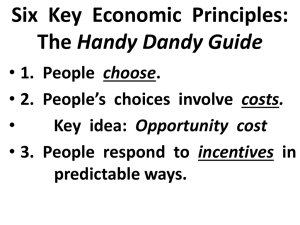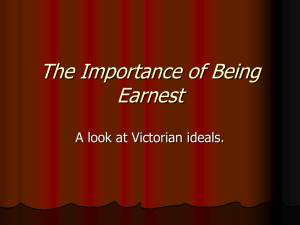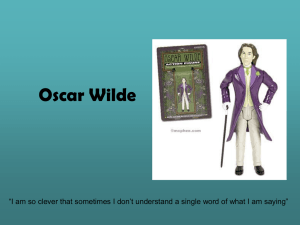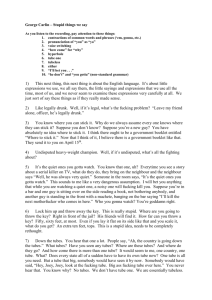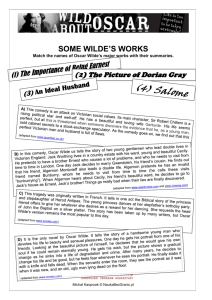Dandyism: Beyond Fashion
advertisement
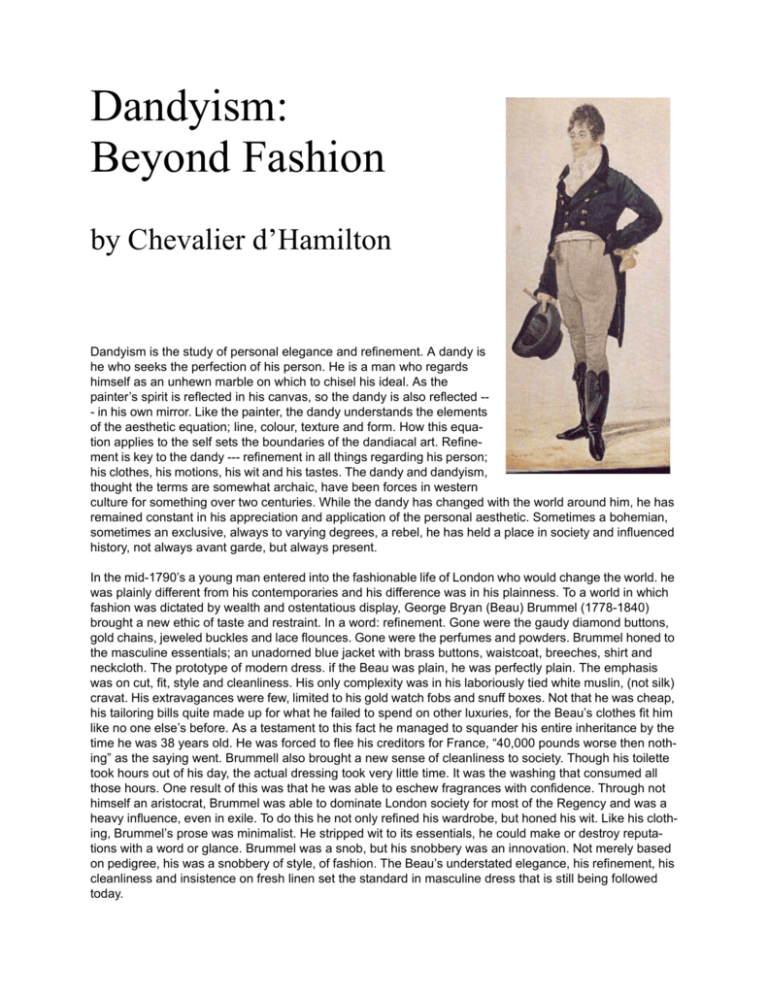
Dandyism: Beyond Fashion by Chevalier d’Hamilton Dandyism is the study of personal elegance and refinement. A dandy is he who seeks the perfection of his person. He is a man who regards himself as an unhewn marble on which to chisel his ideal. As the painter’s spirit is reflected in his canvas, so the dandy is also reflected -- in his own mirror. Like the painter, the dandy understands the elements of the aesthetic equation; line, colour, texture and form. How this equation applies to the self sets the boundaries of the dandiacal art. Refinement is key to the dandy --- refinement in all things regarding his person; his clothes, his motions, his wit and his tastes. The dandy and dandyism, thought the terms are somewhat archaic, have been forces in western culture for something over two centuries. While the dandy has changed with the world around him, he has remained constant in his appreciation and application of the personal aesthetic. Sometimes a bohemian, sometimes an exclusive, always to varying degrees, a rebel, he has held a place in society and influenced history, not always avant garde, but always present. In the mid-1790’s a young man entered into the fashionable life of London who would change the world. he was plainly different from his contemporaries and his difference was in his plainness. To a world in which fashion was dictated by wealth and ostentatious display, George Bryan (Beau) Brummel (1778-1840) brought a new ethic of taste and restraint. In a word: refinement. Gone were the gaudy diamond buttons, gold chains, jeweled buckles and lace flounces. Gone were the perfumes and powders. Brummel honed to the masculine essentials; an unadorned blue jacket with brass buttons, waistcoat, breeches, shirt and neckcloth. The prototype of modern dress. if the Beau was plain, he was perfectly plain. The emphasis was on cut, fit, style and cleanliness. His only complexity was in his laboriously tied white muslin, (not silk) cravat. His extravagances were few, limited to his gold watch fobs and snuff boxes. Not that he was cheap, his tailoring bills quite made up for what he failed to spend on other luxuries, for the Beau’s clothes fit him like no one else’s before. As a testament to this fact he managed to squander his entire inheritance by the time he was 38 years old. He was forced to flee his creditors for France, “40,000 pounds worse then nothing” as the saying went. Brummell also brought a new sense of cleanliness to society. Though his toilette took hours out of his day, the actual dressing took very little time. It was the washing that consumed all those hours. One result of this was that he was able to eschew fragrances with confidence. Through not himself an aristocrat, Brummel was able to dominate London society for most of the Regency and was a heavy influence, even in exile. To do this he not only refined his wardrobe, but honed his wit. Like his clothing, Brummel’s prose was minimalist. He stripped wit to its essentials, he could make or destroy reputations with a word or glance. Brummel was a snob, but his snobbery was an innovation. Not merely based on pedigree, his was a snobbery of style, of fashion. The Beau’s understated elegance, his refinement, his cleanliness and insistence on fresh linen set the standard in masculine dress that is still being followed today. Brummel’s unique new mode of masculine dress was not without its influences. The order of the day in design and art was classicism. Greek and Roman formulaic ideals of aesthetics had been brought to England during the Renaissance. These ideals were most obviously applied in neo-classical architecture. The column, the arcade and the pediment were the mainstays of building design in Brummel’s day. The most important classicist of the period was the French paint, Jacques-Louis David (1748-1825). Though mostly a painter, David influenced all aspects of design. His famous Portrait of Madame Recamier (1805, Musee du Louvre, Paris) shows a woman in a diaphanous white gown of draped muslin, reclining on a conspicuously Grecian chaise. yet, this is not a costume piece, the clothing and furniture are David’s own contemporary adaptations of the Greek style. Though Brummel’s new look didn’t emulate Greek or Roman costume, as women’s dress did, it was still classical in essence. What made Brummel Greek was that he followed an ideal of purely masculine beauty. Like David’s paintings, like neo-classical architecture, Brummel distilled men’s fashion into an abstract ideal, a strict mode of thought. Rebellion to all this narrow idealism was inevitable and a new force now entered into the world. That force was personified in the being of Lord Byron. Byron and the romantics were not considered dandies in England. They shunned the stifling life of the city and yearned for the exotic, eccentric and sensual. The classic-romantic split was formed. Though on separate paths the two groups felt no enmity toward one another. In fact, Byron considered Brummel (who, after all, was in his own time, a rebel) the most influential character of the 19th century after Napoleon and himself. The romantics created an opposite sort of image to that of the dandy. The romantic pose was always to appear casual, loose and a little wild. Pose is the key term; it was a casualness that was as highly and painstakingly cultivated as the upright perfection of the dandy. The romantics wore their collars open and unbuttoned to show their pale chests, causing the vapors in decent young ladies. Broad brimmed and soft hats kept their delicate complexions away from the sun, and loose, flowing scarves trailed behind their carriages. Byron, in order to conceal his club-foot, wore long, loose trousers, an innovation that would become an absolute in half a century. Byron didn’t actually invent long pants, but he was the first aristocrat to adopt them from the lower classes. Portrait of Lord Byron by Thomas Phillips, 1814. This portrait was first displayed at the Royal Academy Exhibition in 1814. Phillips also painted the famous portrait of Byron in Albanian dress. In 1815, Napoleon was finally defeated at Waterloo and the world rushed to Paris. English dandyism struck Paris like a thunderbolt. Of course, the French, with characteristic blind-sight, did not differentiate the dandies from the romantics. It all the “Mode l’Anglaise” and therefore, desirable. It is ironic that the Parisienne attitude has its’ origins in the clubs of Regency London. The French took dandyism and romanticism and weaved them into the fabric of French social life. They adopted the dandy and made him their own. In 1819 Beau Brummel fled England and his debts for a penurious exile on the French coast. There he lived out the remainder of his years, gradually losing touch with the qualities which made him great: pride, dignity and refinement. In 1840 he finally died, in a sanatorium in Caen screaming: “Scoundrels, I owe nothing!” Without Brummel’s influence over them, the dandies of London began to slip into innovative extremes. One year might see a wasp waist, another a grotesquely over-sized lapel or an ultra narrow hat brim. Trousers might flair alarmingly for morning dress and then be super tight for evening. Collars crept up and up until, finally, wearing one was like wearing blinders. In France fashionable young me blithely mixed dandiacal and romantic fashions, producing an entirely French effect. Brummel became a sort of fashion icon in mid-century France, but in post-Regency Britain, Brummel’s long decay and death in insanity gave ammunition to a burgeoning anti-dandiacal movement. Writers such as Thackeray and Carlyle, through periodicals such as Fraser’s Magazine, waged an irrepressible war against dandyism, effeminacy, ‘puffery’, and anything else they deemed useless or unmanly. Utilitarianism grew out of the Victorian rejection of Regency ideals (or perhaps its lack of ideals). With the Industrial Revolution plowing ahead at full steam, Regency dandyism and its’ accompanying elitist doctrine were quickly becoming obsolete. The Victorians were somber, serious and practical seeming. That their notions were as narrow-minded and prejudicial as Regency notions were frivolous, hardly occurred to them. With a few notable exceptions, such as the butterfly dandy Count d’Orsay, the dandy all but disappeared from the English scene. Men’s dress grew drabber and more serious. Black became the all pervasive colour. The black, square-cut frock coat replaced the elegantly tailed clas-hammer coat. Emphasis on tailoring diminished, as form-fitting garments came to be considered a bit ‘much’ for frumpy Victorian taste. In mid-century France dandyism took on a new form and direction. The Bourgeois Revolution of 1830 had an effect in France similar to what was happening in Victorian England; that of idealizing practicality. Mediocrity, some felt, had become a virtue greater than talent or genius. To stand out from the crowd had become bad manners. In rebellion, the artists, poets, and authors of bohemian Paris adopted dandiacal dress and haughty manners. They created a new bohemian ‘aristocracy’ that was based upon a rejection of bourgeois society and upon faith in their own superiority as artists. Barbey d’Aurevilly, who wrote a biography of Brummel, intellectualized the dandy and gave dandyism a definition that the French artist clique took to heart: anti-vulgarity. Later, writers such as Theophile Gautier, Charles Baudelaire and J.K. Huysman in turn gave the dandy spiritual purpose; dandyism was the outward manifestation of the inner perfection of the self. Baudelaire used the colour black extensively in his wardrobe (and one could say in his poetry as well) for some time before it became the dominant uniform in bourgeois society. He felt that black was the most appropriate colour for an age in mourning and dived into like an evangelist into the Bible. Black from head to toe, from his silk hat, to his long, straight coat, to his stiff cravats, all the way down to his perfectly polished shoes. Even his linen was black. The artists of mid-nineteenth century France felt that art must be created to shock the beholder rather than merely please his eye. They saw the mission of the artist as one that was beyond decorating the walls and libraries of the wealthy bourgeoisie establishment. Art must subvert the viewer into a critical examination of himself. Therefore, the artist must be shocking not only in his works but in his dress, manners and his eccentric views. The dandyism that Victorian England vilified and left to the French, the English would reclaim for a brief period and then vilify again. Algernon Swinburne, Walter Pater, the American artist James McNeill Whistler and other enthusiasts of French art and letters, brought to England ‘the art for art’s sake’ doctrine of bohe- mian Paris. The aesthetic movement evolved out of a synthesis of French and English thought. The pivotal character of the movement, its most tenacious spokesman, was Oscar Wilde. Wilde, in his lecture tours, became the prophet of aestheticism to both Britain and America. he called for beauty, style and craftsmanship in the design of all things in order to make life itself a creative art. Clothes were not an exception. Like his French predecessors Wilde dressed to shock. He wore large, rolled-down ‘Byronesque’ collars, pillbox hats and most shocking of all to his Victorian audience, knee breeches with silk stockings and patent leather pumps with moire bows. It is odd that the public found this so shocking. Knee breeches had really only been out of fashion for about sixty-five years and were still the uniform worn at the royal court. Breeches were still widely worn as sporting attire for shooting and mountain climbing. Actually, Wilde simply adapted them from the uniform of the Masonic Order that he had joined while at Oxford. The offensiveness of Wilde’s leg-wear is perhaps a testament to the extremity of Victorian conventionality. Though a life-long Hellenist, Wilde’s early style was deucedly romantic. It was romantic in its historically regressive elements; the knee breeches, the flowing cravats, and the Byronic collar. Wilde also cultivated the long hair and the pose of the artist and the dandy. While the aim of his pose was art, it also served a more down-to-earth purpose; it bought him press. Most of that press was bad; but Wilde said, “There’s only one thing worse than being talked about --- not being talked about.” Wilde became a master manipulator in the art of self-promotion. Thus, his clothes became a weapon employed in his quest for success, as well as a statement of his inner being. A relaxation of social barriers occurred at the close of the Victorian era so that birth, talent and money (old and new) mingled more freely than before. Also, during this period Saville Row made great advances resulting in a renewed interest in fitted clothing and therefore, men’s tailoring. After his initial successes, Wilde’s dress became a little more conventional. he abandoned knee breeches as uncomfortable and adopted long trousers. However, he always maintained a certain sense of style and subtle innovation that the marks the dandy. It was about this time that he invented the green carnation that would become the aesthetic trademark. He gave up the romanticism of youth for the classicism of adulthood; Byron became Brummel. The twentieth century was to open without Oscar Wilde or his aesthetic dandyism. The famed Queensberry affair and his two years in prison left him a broken man. He died in 1900 and was laid to rest in Paris. Oscar Wilde photographed by Hills and Saunders. Dandyism was not to be a part of the art world in the early twentieth century. The new artists were a different breed than their predecessors. They were rough, outdoor sorts who disliked the artificial atmosphere of the salons. They were restless, troubled, wandering men. Their art was all raw emotion. They were romantics without romance. The twentieth century would be for Hemingway and his ilk, not for Baudelaire and company. What was left of the old century was destined to seek its final reward amid the muddy trenches in France. At the close of the nineteenth century the cult of aestheticism had been given a swift kick out the door by the moral jackboot of respectable society. The battle against aestheticism had begun with James McNeill Whistler’s spectacular lawsuit against art critic John Ruskin in 1877 and ended, for the most part, with Oscar Wilde’s crushing defeat against the Marquess of Queensbury in 1895. The later trial, which exposed Wilde’s homosexuality, was used by the moralists of the day as an example to show that aestheticism and its effeminate posing was a sure path toward vice and degradation. Except for a few diehards, such as Max Beerbohm, the artist-dandy fo the nineteenth century ceased to be. If the new century was to do without Oscar Wilde, it was also destined to open without Queen Victoria. The Edwardian era was a breath of fresh air for British libertines. Though homoerotic themes were heavily suppressed, a certain relaxation of morals did occur; perhaps due to the new king’s rather prolific tastes in women, wine and gaming of all kinds. Men’s tailoring in this age took positive leaps forward with many imaginative and technical innovations in line, fabric, and cut. This ‘renaissance’ was, however, both shortlived and superficial. The innovations did not come from the tailor dressing the subject. Tailors were becoming designers. Saville Row was giving order, not taking them. Though the young fashionables of the Edwardian era were sometimes referred to as dandies, they were not dandies in the same mold as the aesthetics or those of previous eras. The new exquisites made themselves slaves to fashion, rather than making fashion their slave. Besides, there was now a rather nasty stigma attached to that term. The young men would rather be called something else. In 1914 all of Europe, precariously balanced atop a complex system of treaties, collapsed into war. The finest young men of the age were relentlessly mowed down as they charged wave upon wave into enemy machine-gun fire. For the first time in history whole nations, vast economies, millions of lives were restructured for the purpose of making total war. Thus, men’s attire subjugated itself to the largely utilitarian needs of the time. The utilitarian effect was reenforced by the socialization and democratization of the postwar period. There was a certain leveling, at least superficially, between the classes. For example, the frock coat and top hat, worn by British aristocrats and American business tycoons were gradually phased out of everyday dress as ‘too conspicuous’ and were replaced by more informal attire: the shorter suit coat (called a leisure suit) and the bowler and fedora hats. Aristocratic clothing has now become what is known as ‘formal wear’, worn on special occasions and has a sort of folk-costume air in the wearing of it. The two men in this photo are wearing business suites typical of the 1920s, but the style is little changed from men’s suits today. The advent of moving pictures froze a particular image of male costume. The male uniform has remained more or less static for the past 70 odd years. By the male uniform I am referring to that which is acceptable in the office and at social functions. The suit, consisting of trousers, vest and jacket and the sport coat and slacks of more casual attire have really changed only in regard to the cut, width and size of the lapel and the shape of the tie. The tie, which seems to have undergone the least innovation, may now only be tied in a few acceptable knots; all of which look pretty much the same. This contrasts with the nineteenth century when the tie as well as the other elements of men’s dress, underwent continual evolution on an almost yearly basis. It is not because men’s attire has reached its final, most perfect phase that is has remained the same; rather, the image of what a man is supposed to look like has remained frozen in time by film and later by television. Three soldier pals during World War II. Their pose, body language and clothing are all casual and informal. World War II once again reinforced this uniformity and in the United States added a sort of G.I. casualness. The 1950’s (the McCarthy era) though showing some innovation in cut and fabric was a homogenous decade. Except for an emerging ‘Beat’ movement and the notable exception of the artistposeur Salvador Dali, the 1950’s had little to do with aesthetic dandyism. The last quarter of the twentieth century has seen dramatic changes in our moral vision. The 1960’s and 1970’s were hog wild for outlandish clothing. The casualness spawned in World War II was taken to extremes in the late 1960’s and early 1970’s; an extreme which, to some extent, continues today. A young journalist appeared on the scene during this time that would bring back some fo the tradition of the literary dandies of bohemian Paris. Tom Wolfe, like Balzac, was able to capture in his writing the feeling of the day. Like Theophile Gautier, like Oscar Wilde, Tom Wolfe made his first impressions not with his pen, but with his appearance. Wolfe adopted white as his champion colour in all seasons. His accessories, hats, high shirt collars, his flamboyant ties, and walking stick were often historically regressive, harkening back to Wilde and the pre-war era. Another writer, the English born, New York City gay film critic Quentin Crisp, also made a name for himself through an innovative flamboyance in dress, as well as through his outspoken condemnation of the repression of homosexuality. Throughout the sartorial history of men of taste, we may identify three main classes of dandy: the classical, the romantic, and the sportive. The first type, the classical, rigorously applies a more or less Brummelian concept of masculine form to his daily dress. He does not copy Brummel or the fashions of his day, rather he applies those original rules to modern dress. The navy double-breasted jacket with brass buttons worn with khaki trousers, popular among country club types, is a direct descendent from Brummel’s blue clawhammer coat and tight tan breeches. Like the sonnet or this haiku, the classical is perhaps the most refined form of the dandy, because, like the poet utilizing those forms, the dandy must succeed within a limited framework. Details are the classical dandy’s aesthetic toys. The precise cut of a coat, the colour and fold of a pocket square, the tilt of a hat; these are the vehicles by which he sends his message.The romantic, on the other hand, dresses to fit a particular mood or create a particular mood in his audience. he will utilize those elements which appeal to his creativity regardless of their fashionableness. He is often a nostalgic dresser, incorporating the historically regressive elements into his wardrobe. The sportive dandy is just as the name suggests. Into his daily ensemble he works elements of riding, hunting, golf or cycling. Of course, such lines are never clearly drawn and always overlap. In his youth, Oscar Wilde was most definitely a romantic (at least in his dress) of the Pre-Raphaelite school., but after success settled into a more classical mode. Tom Wolfe is a classical dandy who incorporates certain romantic (nostalgic) elements in his attire. This brings us to our own crazy era and how dandyism, if it exists, applies today. I first stated dandyism is the art of personal elegance and refinement, that it involves applying an ideal of masculine beauty. As in Brummel’s day, so it is now. In a world where machines are worn as jewelry, where tee-shirts printed with vulgar sayings are commonplace, where beauty plays almost no role in the fashion establishment, the dandy seeks to counter the vulgarity around him. Dandyism has been defined as simple anti-vulgarity, for its own sake. The question, “What are you trying to prove by wearing that?” is meaningless to the dandy. How the articles in themselves are worn is an end in itself. The medium is the message. L’art pour l’art. In this sense the dandy becomes an artist in cloth. He may not make his clothes, but he wears them well. Furthermore, the modern dandy knows no bounds but those of good taste. He may go from a Dunhill to a Salvation Army store without a blink, for either shop might yield that perfect item he seeks. Lastly the dandy is never a fashion victim because fashion is for people without style. Charles Farrell (1901-1990) was a popular actor in the 1920’s and 1930’s. He made 12 films with Janet Gaynor; the press identified them as one the Dream Couples of popular cinema. Charles Farrell dressed well and wore clothes with an easy elegance that was the height of sophistication in the Deco era. Further Reading The Aesthetic Adventure by William Gaunt, Pelican Books, 1945. Costume and Fashion by James Laver, Thames & Hudson, 1969. The Cowboy and the Dandy: Crossing Over from Romanticism to Rock and Roll by Perry Meisel, Oxford University Press, 1998. The Culture of Clothing: Dress and Fashion in the Anien Regime by Daniel Roche, Jean Birrell (Translator) and Lyndal Roper (Editor), Cambridge University Press, 1996. The Dandy and the Herald: Manners, Mind and Morals from Brummel to Durrell by Richard Pine, St. Martin’s Press, 1988. The Dandy: Brummell to Beerbohm by Ellen Moers, University of Nebraska Press, 1978. Dandies and Desert Saints: Styles of Victorian Masculinity by James Eli Adams, Cornell University Press, 1995. Dandies: Fashion and Finesse in Art and Culture by Susan Fillen-Yeh (Editor), New York University Press, 2001. The English Gentleman: The Rise and Fall of an Ideal by Philip Mason, William Morrow Pub., 1982. The Figure of the Dandy in Barbey D’Aurevilly’s “Le Bonheur Dans Le Crime” (Sexuality and Literature, Vol 4) by Davina L. Eisenberg, Peter Lang Publishing, 1996. A Glam Man in a Dandy World: Secret Relations Between Dandy Style and Linin’ and Glam Way of Thinkin’ by Giulio D’Agostino, Writers Club Press, 2001. How to Be a Complete Dandy: A Little Guide for Rakes, Bucks, Swells, Cads and Wits by Stephen Robins, Prion Books, 2002. The Last of the Dandies: The Scandalous Life and Escapades of Count D’Orsay by Nick Foulkes, Thomas Dunne Books, 2004. The Male Image: Men’s Fashions in Britain, 13001970 by Penelope Byrde, Prometheus Books, 1980. The Man of Fashion: Peacock Males and Perfect Gentlemen by Colin McDowell, Thames & Hudson, 1997. Of Human Finery by Quentin Bell, Scnocken Books, 1976 Our Tempestuous Day by Carolyn Erickson, William Morrow & Co., 1986. A Perfect Fit: Clothes, Character, and the Promise of America by Jenna Weissman Joselit, Owl Books, 2002. Undressing Cinema: Clothing and Identity in the Movies by Stella Bruzzi, Routledge Pub., 1998. Who’s A Dandy? Dandyism and Beau Brummell by Geoge Walden (Translator), Jules Barbey and Jules Barbey d’Aurevilly, Gibson Square Pub., 2002.
